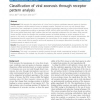BMCBI
2011
13 years 6 months ago
2011
Background: The way mechanical stress is distributed inside and propagated by proteins and other biopolymers largely defines their function. Yet, determining the network of intera...
BMCBI
2011
13 years 6 months ago
2011
Background: It is difficult to accurately interpret chromosomal correspondences such as true orthology and paralogy due to significant divergence of genomes from a common ancestor...
BMCBI
2011
13 years 6 months ago
2011
Background: In the last decades, microarray technology has spread, leading to a dramatic increase of publicly available datasets. The first statistical tools developed were focuse...
BMCBI
2011
13 years 6 months ago
2011
Background: Methods of determining whether or not any particular HIV-1 sequence stems - completely or in part - from some unknown HIV-1 subtype are important for the design of vac...
BMCBI
2011
13 years 6 months ago
2011
Background: Viral zoonosis, the transmission of a virus from its primary vertebrate reservoir species to humans, requires ubiquitous cellular proteins known as receptor proteins. ...
BMCBI
2011
13 years 6 months ago
2011
Background: Microarrays offer great potential as a platform for molecular diagnostics, testing clinical samples for the presence of numerous biomarkers in highly multiplexed assay...
BMCBI
2011
13 years 6 months ago
2011
Background: Gene-gene epistatic interactions likely play an important role in the genetic basis of many common diseases. Recently, machine-learning and data mining methods have be...
BMCBI
2011
13 years 6 months ago
2011
BMCBI
2011
13 years 6 months ago
2011
Background: Influenza A viruses exhibit complex epidemiological patterns in a number of mammalian and avian hosts. Understanding transmission of these viruses necessitates taking ...
BMCBI
2011
13 years 6 months ago
2011
Background: Next-generation sequencing technologies have led to the high-throughput production of sequence data (reads) at low cost. However, these reads are significantly shorter...

